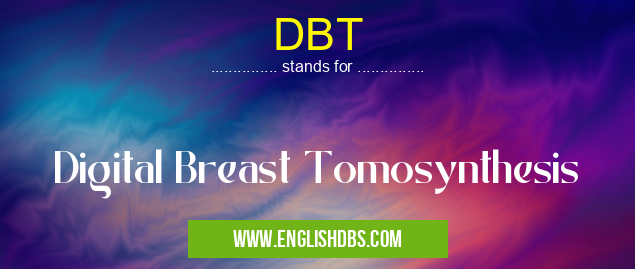What does DBT mean in UNCLASSIFIED
Digital Breast Tomosynthesis (DBT) is an imaging technique used by physicians to detect and diagnose breast cancer. It is a three-dimensional method of X-ray imaging that uses low-dose radiation to produce detailed images of the internal structures of the breast. This technology enables the physician to detect and diagnose diseases in the breast with greater accuracy than traditional two-dimensional mammography. The use of DBT also reduces false positives that may lead to unnecessary biopsies or treatments.

DBT meaning in Unclassified in Miscellaneous
DBT mostly used in an acronym Unclassified in Category Miscellaneous that means Digital Breast Tomosynthesis
Shorthand: DBT,
Full Form: Digital Breast Tomosynthesis
For more information of "Digital Breast Tomosynthesis", see the section below.
Definition
Digital Breast Tomosynthesis (DBT) is an advanced form of mammography that produces a 3D image of the breast for better detection and diagnosis of breast cancer. Unlike 2D mammograms, which take just one picture from a single angle, DBT takes multiple pictures from different angles, creating a more comprehensive 3D image. This allows radiologists to distinguish healthy tissue from tumors or other abnormalities with greater clarity and accuracy than traditional mammography.
Advantages
The use of Digital Breast Tomosynthesis (DBT) provides several advantages over traditional two-dimensional mammography. First, the 3D images produced by DBT can reveal abnormalities more effectively since they allow radiologists to identify lesions located deep inside the pads of breast tissue. Additionally, because it takes multiple pictures from different angles, it reduces false positives due to overlapping tissue or shadows that occur with 2D imaging techniques. Furthermore, due to its low dose radiation levels compared with other exams, it minimizes radiation exposure for patients without reducing image quality.
Disadvantages
Despite its advantages, there are some disadvantages associated with Digital Breast Tomosynthesis (DBT). The cost for this type of imaging is significantly higher than what you would pay for traditional two-dimensional mammography exams; therefore, some clinics may not offer it as an option due to budget constraints. Additionally, it requires specialized equipment as well as skilled personnel trained in its use; this can make access difficult in certain areas where there isn't sufficient expertise available to operate such technology properly and safely.
Essential Questions and Answers on Digital Breast Tomosynthesis in "MISCELLANEOUS»UNFILED"
What is Digital Breast Tomosynthesis?
Digital Breast Tomosynthesis (DBT) is a 3-dimensional imaging technique used in mammography to detect and diagnose breast diseases and cancer. DBT produces clear images of the breast tissue without any overlapping of different tissues, allowing clinicians to observe minute details more accurately.
How does Digital Breast Tomosynthesis work?
During DBT imaging, an x-ray tube rotates around the breast while multiple low-dose x-rays are taken from different angles. The information acquired during this process is then processed using special computer algorithms that generate thin slices of the breast, giving clinicians a 3D view of the tissue.
Is Digital Breast Tomosynthesis invasive?
No, DBT is a non-invasive imaging technology that uses x-rays to create 3D images of the breast tissue. It does not involve contact with or insertion of any instruments or devices into the body.
Is Digital Breast Tomosynthesis safe?
Yes, DBT has been proven to be just as safe as conventional 2D mammography, and in fact may even reduce radiation exposure compared to conventional mammograms.
Does Digital Breast Tomosynthesis require preparation?
Yes, like other imaging techniques like MRI and CT scans, there are certain preparations required for DBT imaging such as avoiding deodorant or antiperspirant on the day of the scan and removing jewelry before the scan.
How long does a typical DBT session take?
A typical DBT session usually takes around 10 minutes from start to finish, though it may vary depending on factors such as body weight or size of breasts.
Are there any risks associated with Digital Breast Tomosynthesis?
As with any medical procedure involving radiation exposure risk, there is always some risk associated with a DBT scan. However, these risks are minimal due to its low dose levels compared to other forms of radiation therapy treatments such as chemotherapy or even ordinary X-Rays.
Will I feel anything during a Digital Breast Tomosynthesis procedure?
No, you will not feel anything during a DBT procedure since it does not involve any contact with your body at all; it only involves passing an x-ray beam through your breasts for imaging purposes only.
Final Words:
Digital Breast Tomosynthesis (DBT) is an advanced form of imaging technology used in medical diagnostics that uses low radiation doses while providing improved detection and diagnosis capabilities compared with traditional two-dimensional mammography methods. Its qualities make it ideal for identifying suspicious lesions located deep within pads of tissue and reduce false positives through multi-angle imaging techniques; however, its high cost means access may be limited in certain areas where resources are scarce or unavailable.
DBT also stands for: |
|
| All stands for DBT |
